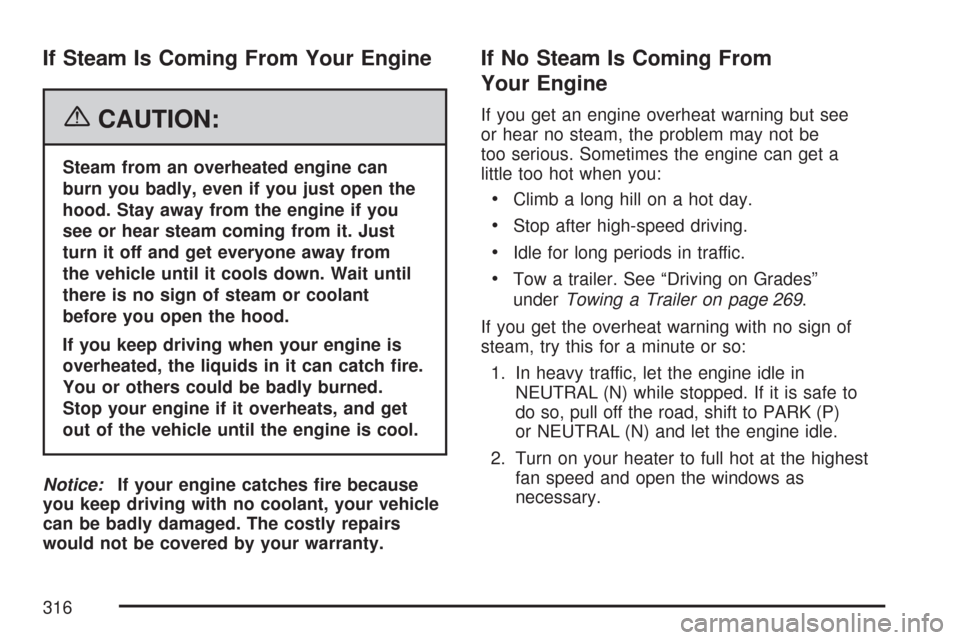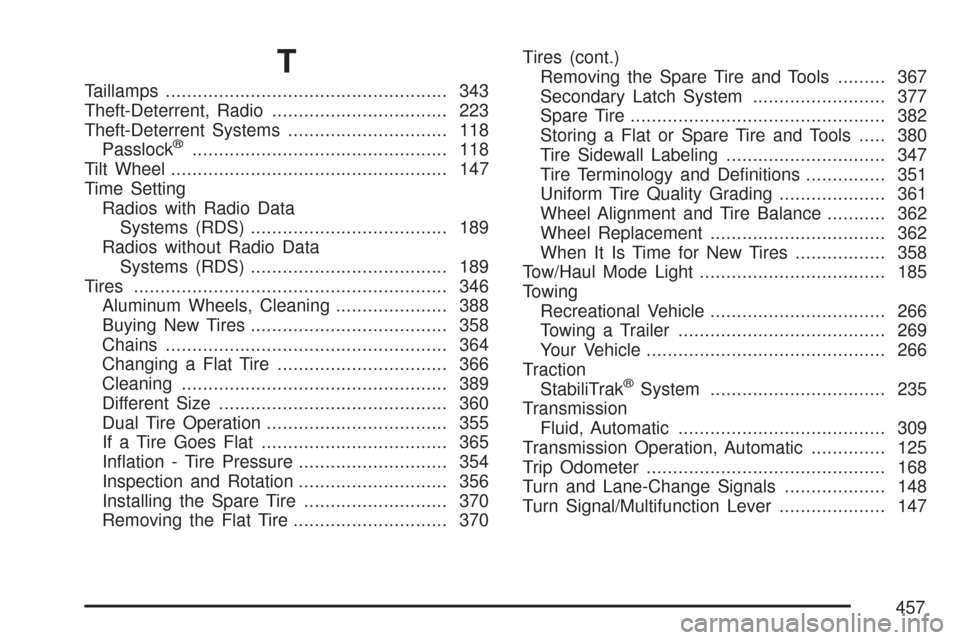2007 CHEVROLET EXPRESS PASSANGER towing
[x] Cancel search: towingPage 316 of 458

If Steam Is Coming From Your Engine
{CAUTION:
Steam from an overheated engine can
burn you badly, even if you just open the
hood. Stay away from the engine if you
see or hear steam coming from it. Just
turn it off and get everyone away from
the vehicle until it cools down. Wait until
there is no sign of steam or coolant
before you open the hood.
If you keep driving when your engine is
overheated, the liquids in it can catch �re.
You or others could be badly burned.
Stop your engine if it overheats, and get
out of the vehicle until the engine is cool.
Notice:If your engine catches �re because
you keep driving with no coolant, your vehicle
can be badly damaged. The costly repairs
would not be covered by your warranty.
If No Steam Is Coming From
Your Engine
If you get an engine overheat warning but see
or hear no steam, the problem may not be
too serious. Sometimes the engine can get a
little too hot when you:
•Climb a long hill on a hot day.
•Stop after high-speed driving.
•Idle for long periods in traffic.
•Tow a trailer. See “Driving on Grades”
underTowing a Trailer on page 269.
If you get the overheat warning with no sign of
steam, try this for a minute or so:
1. In heavy traffic, let the engine idle in
NEUTRAL (N) while stopped. If it is safe to
do so, pull off the road, shift to PARK (P)
or NEUTRAL (N) and let the engine idle.
2. Turn on your heater to full hot at the highest
fan speed and open the windows as
necessary.
316
Page 323 of 458

Engine Fan Noise
Your vehicle has a clutched engine cooling fan.
When the clutch is engaged, the fan spins faster
to provide more air to cool the engine. In most
everyday driving conditions, the fan is spinning
slower and the clutch is not fully engaged.
This improves fuel economy and reduces fan
noise. Under heavy vehicle loading, trailer towing,
and/or high outside temperatures, the fan speed
increases as the clutch more fully engages,
so you may hear an increase in fan noise.
This is normal and should not be mistaken as the
transmission slipping or making extra shifts. It
is merely the cooling system functioning properly.
The fan will slow down when additional cooling
is not required and the clutch partially disengages.
You may also hear this fan noise when you
start the engine. It will go away as the fan
clutch partially disengages.
Power Steering Fluid
The power steering fluid
reservoir is located in
the engine compartment
on the driver’s side of
the vehicle. SeeEngine
Compartment Overview
on page 302for
reservoir location.
When to Check Power Steering Fluid
It is not necessary to regularly check power
steering fluid unless you suspect there is a leak
in the system or you hear an unusual noise.
A fluid loss in this system could indicate a problem.
Have the system inspected and repaired.
323
Page 410 of 458

(c)Visually inspect hoses and have them replaced
if they are cracked, swollen, or deteriorated.
Inspect all pipes, �ttings, and clamps; replace with
genuine parts as needed. To help ensure proper
operation, a pressure test of the cooling system
and pressure cap and cleaning the outside of the
radiator and air conditioning condenser is
recommended at least once a year.
(d)Inspect wiper blades for wear, cracking,
or contamination. Clean the windshield and wiper
blades, if contaminated. Replace wiper blades
that are worn or damaged. See Windshield Wiper
Blade Replacement on page 344 and Windshield
and Wiper Blades on page 387 for more
information.
(e)Make sure the safety belt reminder light and
all belts, buckles, latch plates, retractors, and
anchorages are working properly. Look for
any other loose or damaged safety belt system
parts. If you see anything that might keep a safety
belt system from doing its job, have it repaired.
Have any torn or frayed safety belts replaced.
Also look for any opened or broken airbag
coverings, and have them repaired or replaced.
The airbag system does not need regular
maintenance.(f)Lubricate all key lock cylinders, hood hinges,
hood prop rod pivot, hood latch assembly,
secondary latch, pivots, spring anchor, release
pawl, rear compartment hinges, latches, locks, fuel
door hinge, and any moving seat hardware. More
frequent lubrication may be required when exposed
to a corrosive environment. Applying silicone grease
on weatherstrips with a clean cloth will make them
last longer, seal better, and not stick or squeak.
(g)Vehicles with Gross Vehicle Weight Rating
(GVWR) above 10,000 lbs (4 536 kg) only: Inspect
shields for damage or looseness. Adjust or
replace as required. This is a Noise Emission
Control Service. Applicable to vehicles sold in the
United States and recommended for vehicles
sold in Canada.
(h)Change automatic transmission �uid and �lter
if the vehicle is mainly driven under one or
more of these conditions:
-In heavy city traffic where the outside
temperature regularly reaches 90°F (32°C)
or higher.
-In hilly or mountainous terrain.
-When doing frequent trailer towing.
-Uses such as found in taxi, police,
or delivery service.
410
Page 432 of 458

For prompt and efficient assistance when calling,
please provide the following to the Roadside
Assistance Representative:
•Your name, home address, and home
telephone number
•Telephone number of your location
•Location of the vehicle
•Model, year, color, and license plate number
of the vehicle
•Odometer reading, Vehicle Identification
Number (VIN), and delivery date of the vehicle
•Description of the problem
Chevrolet and General Motors of Canada Limited
reserve the right to limit services or reimbursement
to an owner or driver when, in their sole
discretion, the claims become excessive in
frequency or type of occurrence.
Roadside Assistance is not part of or included in
the coverage provided by the New Vehicle Limited
Warranty. Chevrolet and General Motors of
Canada Limited reserve the right to make any
changes or discontinue the Roadside Assistance
program at any time without notification.
Towing and Road Service Exclusions
Specifically excluded from Roadside Assistance
coverage are towing or services for vehicles
operated on a non-public roadway or highway,
fines, impound towing caused by a violation
of local, Municipal, State, Provincial, or Federal
law, and mounting, dismounting or changing
of snow tires, chains, or other traction devices.
Courtesy Transportation
To enhance your ownership experience, we and
our participating dealers are proud to offer
Courtesy Transportation, a customer support
program for new vehicles.
For warranty repairs during the Bumper-to-Bumper
(U.S.) or Base Warranty Coverage period
(Canada), provided by the New Vehicle Limited
Warranty, interim transportation may be available
under the Courtesy Transportation program.
Several courtesy transportation options are
available to assist in reducing your inconvenience
when warranty repairs are required.
432
Page 437 of 458

•If your vehicle cannot be driven, know where
the towing service will be taking it. Get a
card from the tow truck operator or write down
the driver’s name, the service’s name, and
the phone number.
•Remove any valuables from your vehicle
before it is towed away. Make sure this
includes your insurance information and
registration if you keep these items in
your vehicle.
•Gather the important information you will
need from the other driver. Things like name,
address, phone number, driver’s license
number, vehicle license plate, vehicle make,
model and model year, Vehicle Identification
Number (VIN), insurance company and
policy number, and a general description
of the damage to the other vehicle.
•If possible, call your insurance company from
the scene of the accident. They will walk you
through the information they will need. If
they ask for a police report, phone or go to
the police department headquarters the
next day and you can get a copy of the report
for a nominal fee. In some states/provinces
with “no fault” insurance laws, a report may not
be necessary. This is especially true if there
are no injuries and both vehicles are driveable.
•Choose a reputable collision repair facility
for your vehicle. Whether you select a
dealer/retailer or a private collision repair
facility to fix the damage, make sure you are
comfortable with them. Remember, you
will have to feel comfortable with their work
for a long time.
•Once you have an estimate, read it carefully
and make sure you understand what work
will be performed on your vehicle. If you
have a question, ask for an explanation.
Reputable shops welcome this opportunity.
437
Page 455 of 458

Rear Outside Passenger Positions, Safety
Belts.......................................................... 34
Rear Safety Belt Comfort Guides.................. 37
Rear Seat Operation..................................... 13
Rearview Mirror, Automatic Dimming with
Compass and Temperature Display.......... 134
Rearview Mirrors......................................... 134
Reclining Seatbacks...................................... 10
Recommended Fluids and Lubricants.......... 415
Recreational Vehicle Towing........................ 266
Reduced Engine Power Light...................... 184
Remote Keyless Entry (RKE) System.......... 104
Remote Keyless Entry (RKE) System,
Operation................................................. 105
Removing the Flat Tire and Installing the
Spare Tire................................................ 370
Removing the Spare Tire and Tools............ 367
Replacement Bulbs..................................... 344
Reporting Safety Defects
Canadian Government............................. 439
General Motors........................................ 439
United States Government....................... 438
Restraint System Check
Checking the Restraint Systems................. 98
Replacing Restraint System Parts After
a Crash.................................................. 98Retained Accessory Power (RAP)................ 121
Right Front Passenger Position, Safety
Belts.......................................................... 32
Roadside
Assistance Program................................. 430
Rocking Your Vehicle to Get it Out.............. 260
Routing, Engine Drive Belt.......................... 418
Running the Engine While Parked............... 133
S
Safety Belt
Passenger Reminder Light....................... 169
Pretensioners............................................. 40
Reminder Light........................................ 168
Safety Belts
Care of.................................................... 385
Center Passenger Position.................. 33, 34
Driver Position........................................... 23
How to Wear Safety Belts Properly............ 22
Questions and Answers About Safety
Belts....................................................... 21
Rear Outside Passenger Positions............. 34
Rear Safety Belt Comfort Guides............... 37
Right Front Passenger Position.................. 32
Safety Belt Extender.................................. 40
455
Page 457 of 458

T
Taillamps..................................................... 343
Theft-Deterrent, Radio................................. 223
Theft-Deterrent Systems.............................. 118
Passlock
®................................................ 118
Tilt Wheel.................................................... 147
Time Setting
Radios with Radio Data
Systems (RDS)..................................... 189
Radios without Radio Data
Systems (RDS)..................................... 189
Tires........................................................... 346
Aluminum Wheels, Cleaning..................... 388
Buying New Tires..................................... 358
Chains..................................................... 364
Changing a Flat Tire................................ 366
Cleaning.................................................. 389
Different Size........................................... 360
Dual Tire Operation.................................. 355
If a Tire Goes Flat................................... 365
Inflation - Tire Pressure............................ 354
Inspection and Rotation............................ 356
Installing the Spare Tire........................... 370
Removing the Flat Tire............................. 370Tires (cont.)
Removing the Spare Tire and Tools......... 367
Secondary Latch System......................... 377
Spare Tire................................................ 382
Storing a Flat or Spare Tire and Tools..... 380
Tire Sidewall Labeling.............................. 347
Tire Terminology and Definitions............... 351
Uniform Tire Quality Grading.................... 361
Wheel Alignment and Tire Balance ........... 362
Wheel Replacement................................. 362
When It Is Time for New Tires................. 358
Tow/Haul Mode Light................................... 185
Towing
Recreational Vehicle................................. 266
Towing a Trailer....................................... 269
Your Vehicle............................................. 266
Traction
StabiliTrak
®System................................. 235
Transmission
Fluid, Automatic....................................... 309
Transmission Operation, Automatic.............. 125
Trip Odometer............................................. 168
Turn and Lane-Change Signals................... 148
Turn Signal/Multifunction Lever.................... 147
457